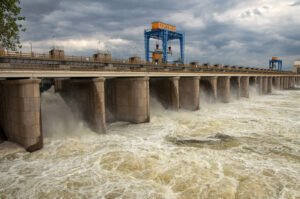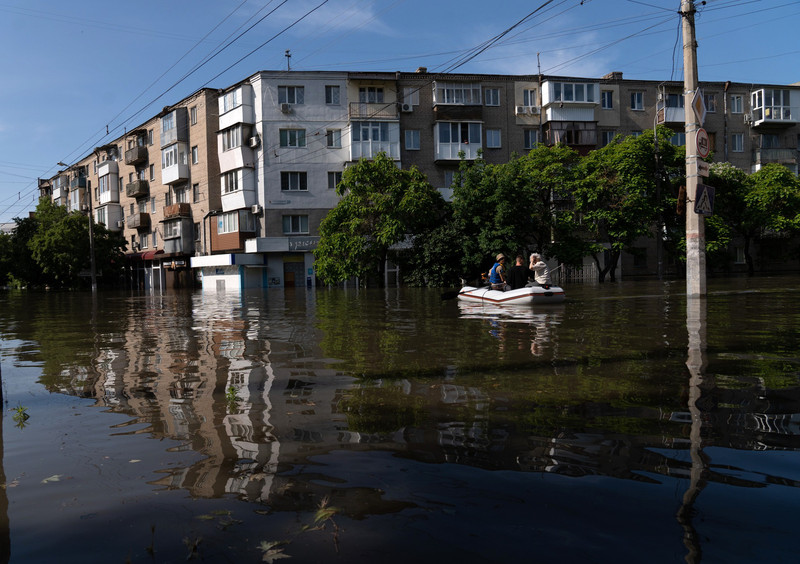By Josh Klemm, International Rivers Co-Director and Oleksii Vasyliuk, co-founder Ukrainian Nature Conservation Group (UNCG). Originally published in the EU Observer.
The destruction of the Kakhovka hydropower dam has precipitated the manmade disaster unfolding in Ukraine, the impacts of which will be experienced by the environment and people for generations to come. Dams must not be used as a weapon of war.
The destruction of the Kakhovka dam has severely affected the lives of hundreds of thousands of people upstream and downstream, impacted over 40 protected natural areas with dozens of endemic species, exposed or carried to the sea the toxic sediments accumulated in the reservoir over the dam’s 70-year history, inundated at least 50 settlements on both banks causing mass displacement, and cut off water up to 500,000 hectares of irrigated fields, among other impacts.

This ecological catastrophe and large-scale destruction of nature provoked by the Russian invasion are undermining the future well-being of all of Europe. Restoring a new livable environment will take many years if not many decades.
This destruction of the dam represents the most serious single blow to the environment during this war, constituting a war crime that should be investigated by the International Criminal Court as “ecocide” or another appropriate article of international law. The international community should hold Russia accountable for all the myriad environmental and humanitarian crimes committed during this war.
The unfolding tragedy has not prevented the dam industry from promoting its services, even while the flood waters were still drowning towns located downstream.
The International Hydropower Association (IHA), in a statement that conspicuously avoided mention of Russia starting the war, pledged to support “the redevelopment and reconstruction process as and when the time comes,” hinting at future lucrative contracts.
The day after the blast at the Kakhovka dam, the IHA celebrated the release of the new “Hydropower Outlook,” calling for doubling the world’s hydropower fleet while ignoring the negative impacts of this industry and the catastrophe underway in Ukraine.
Meanwhile, the bursting of the Kakhovka dam caused by the brutal Russian military invasion in Ukraine has reminded humankind that large dams can often be a weapon of mass destruction. Building dams upstream of populated areas can threaten the lives of thousands — in the case of Kakhovka, 40,000 people live in harm’s way, at least 50 of whom have been already confirmed dead and up to a thousand are still missing.
The deluge has also taken a heavy toll on natural ecosystems and biodiversity of the unique wetlands and valleys of the Lower Dnieper — one of Europe’s largest rivers.
Unsafe in times of peace, these dams become a mortal danger in times of war, civil unrest, and terrorist insurgence.
This disaster also represents a glaring reminder of the dangers that dams can pose. In addition to warfare, dams are increasingly at risk of failure as decades-old dams reach the end of their lifespans, and climate change-induced floods threaten dams and communities located downstream. By 2050, most people will live downstream of a large, ageing dam.
More than ever Ukraine needs support for its speedy and sustainable recovery. However, the destruction of obsolete Soviet infrastructure also brings an opportunity for economic, social, and environmental improvements by using new efficient and nature-friendly approaches and technologies while avoiding mistakes of the past.
The restoration of the 350 MW Kakhovka hydropower plant has been estimated to cost over €1bn, though the full cost is likely to be much greater when factoring in the restoration of the vast reservoir. It would also take years to complete, and restoring water supply from the reservoir to Crimea may take over a decade. Rebuilding the dam and its 2,000 km2 reservoir would not represent the best path forward given its extraordinary expense, high environmental impacts, climate vulnerability, remaining threat of destruction, and availability of more sustainable solutions.
A comparable solar power plant, for example, would occupy less than one percent of the former reservoir area, cost a fraction of restoring the hydropower facility, and could be completed in less than two years.
Dedicated water supply systems and more water-efficient irrigation schemes that do not require restoring the dam can and must be undertaken immediately, rather than choosing an option that would take many years to complete. These efforts are already underway.
Developing solar energy in the former reservoir could serve to power pumps for new water systems while protecting native vegetation from drought. This could be complemented by wind farms to harness naturally strong winds in the valley. The emergence of over 1,000 km2 of vacant land is a real opportunity to develop renewable energy and other nature-friendly economic activities.
Sustainable and beneficial alternatives are possible if supportive governments and international companies genuinely decide to help the sustainable development of Ukraine, not just see a future “recovery” as a business opportunity for industries no longer welcome at home.
As Ukraine and its allies plan the post-war recovery, they should chart a way forward from what this terrible disaster represents, to implement a truly sustainable recovery.
Featured image: Survivors in Kherson, the day after the destruction of the dam (Photo: Wikimedia)
Oleksii Vasyliuk is chairman of the Ukrainian Nature Conservation Group and Oleksii Vasyliuk is chairman of the Ukrainian Nature Conservation Group. Josh Klemm is co-executive director at International Rivers.

